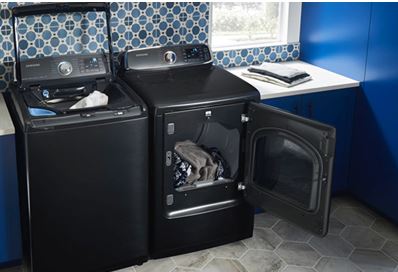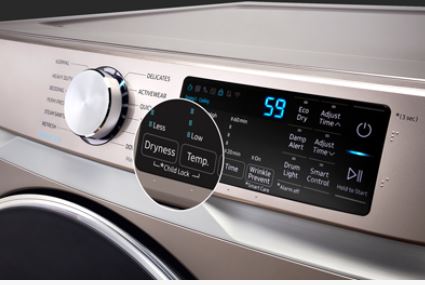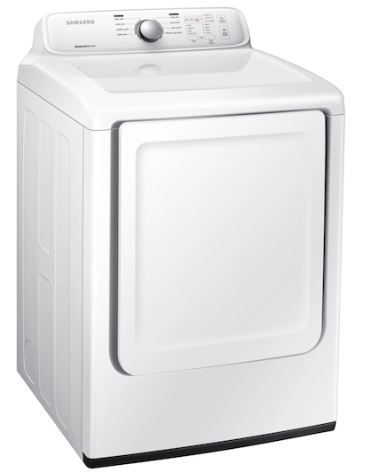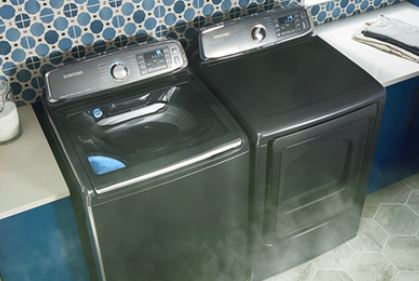Samsung dryers employ different technologies, and one of the finest is moisture-sensing, where the dryer establishes the correct moisture level and determines the right dry cycle length. But as good as this technology is, cases of a Samsung moisture sensor dryer not heating are never avoidable.
A Samsung moisture sensor dryer may fail to heat due to an error code, failed power or gas supply, wrong setting, incorrect laundry distribution, lint filter clogging, vent blockage, unlatched door, clogged moisture sensor, burnt heating element, or failed component.
Concerning failed components, it could be the thermostat, motor, timer, or control board. That, however, should come as the last resort as it can be slightly too technical and may need expert help.
This guide will help you identify which of those 11 issues stops your moisture sensor dryer from getting hot and how to remedy it. But first, let’s briefly discuss how the moisture sensor technology works on a Samsung dryer.
Here we go!

In a rush? Below is a quick guide to troubleshooting a Samsung moisture sensor dryer that won’t get hot:
Samsung Moisture Sensor Dryer Not Heating Up – Quick Troubleshooting Guide
| – | Likely Reason | Quick Fix |
| 1. | Error Code | Reset the error code. |
| 2. | Failed Power Supply | Ensure the moisture sensor dryer has power. |
| 3. | Failed Gas Supply (Gas-Only Models) | Ensure there’s gas and that the supply line is turned on. |
| 4. | Wrong Setting | Cancel Eco Dry, Air Fluff, Perm Press, or any other wrong, unintended, or low-heat cycle. |
| 5. | Incorrect Laundry Distribution | Appropriately distribute the laundry – don’t overload or underload the dryer. |
| 6. | Lint Filter Clogging | Clean the lint filter and wipe it dry. |
| 7. | Vent Blockage | Clear any clogging from the exhaust vent and straighten out any kinks. |
| 8. | Unlatched Door | Ensure the dryer door latches firmly. |
| 9. | Clogged Moisture Sensor | Clean the moisture sensor. |
| 10. | Burnt Heating Element | Replace the heating element if it appears burnt. |
| 11. | Failed Component | Replace a defective thermostat, motor, timer, or control board, or get an expert to help you. |
How Does the Moisture Sensor Work in a Samsung Dryer?
At times known as the plate sensor, the moisture sensor monitors the amount of moisture in the wet clothes you want to dry with a Samsung dryer and relays the signal to the control board, which establishes how long the drying cycle should last and when to stop drying.
Once the moisture sensor fails, it becomes harder for the control board to establish the clothes’ moisture level, which could cause the dryer to over-dry them. In the end, your dryer may spend too much energy unnecessarily.
So, in essence, the moisture sensor technology enables the dryer to heat correctly and saves on energy. That explains why Samsung moisture sensor dryers are among the most fuel-efficient on the market.
Why Is My Samsung Moisture Sensor Dryer Not Heating?
A Samsung moisture sensor dryer fails to get hot for different reasons, and it’s not just about the moisture sensor. Here are 11 issues to check when your Samsung moisture sensor dryer won’t heat up:
1. Error Code
Your Samsung moisture sensor dryer won’t heat up if it senses a malfunction. The dryer will usually warn you by displaying an error code.
Here are some Samsung dryer error codes that point to a heating issue:
- FE
- FC
- 9E
- 9C1
- 2E
- 1FC
Fix
Once you note any of the above error codes or any other, check out their meaning online or use your manual and troubleshoot it. Sometimes, all it takes is a quick dryer reset – you need to unplug the dryer and wait 5 minutes to plug it back and power it on.

2. Failed Power Supply
Your Samsung moisture sensor dryer won’t start or get hot without power. It needs electricity to turn on, run, and eventually heat up. If that’s not the case, here are the issues to check:
- Could the dryer be unplugged?
- Could the power cord be defective?
- Might the power outlet not be working?
- Is the circuit breaker tripped up?
- Are you using the extension cord?
If the answer to one of those five questions is yes, you are dealing with a power issue.
Fix
First, ensure the dryer is firmly plugged into a working socket. Don’t plug into the extension cord, as that limits power flow. Instead, plug it into a wall socket.
Using a multimeter, you can check whether the socket and power cord work. The absence of continuity means they aren’t; in such a case, a replacement is necessary.
Don’t forget to reset the circuit breaker if it’s tripped up.
3. Failed Gas Supply (Samsung Moisture Sensor Gas Dryer Not Heating)
You must check for gas supply failure if your moisture sensor dryer is a gas model. There could be pending bills, and thus, your gas supply has been disconnected.
But still, it could be that you haven’t turned on the gas supply. That’s the case if the gas shut-off valve is horizontal when it should be vertical.
Fix
Ensure you’ve gas at home. If you don’t, ensure you clear any pending bills and contact the gas supplier. Moreover, ensure you turn on the gas supply and check for anything blocking it.
4. Wrong Setting
You need a high-heat setting for your dryer to heat and dry the clothes. Sadly, not all settings and cycles promise that.
For example, Eco Dry saves on energy by allowing the dryer to spin but doesn’t produce heat. On the other hand, Air Fluff lets the dryer blow only cold air, while Perm Press enables the dryer to run under extremely low heat to avoid wrinkling.
Fix
Pick the correct dryer cycle and setting to ensure your dryer gets hot enough. Cancel Eco Dry, Air Fluff, Perm Press, or any unintended or low-heat dry cycle.
5. Incorrect Laundry Distribution
It’s essential to load the wet laundry in the dryer properly. If you underload (load it below the ½ line) or overload it (exceed its ¾ capacity), the dryer will have difficulty heating up.
In the case of an underload, the dryer might not even notice that there are any clothes and thus may fail to start running. In the case of an overload, most of the clothes, especially the top ones, will remain soaking wet as hot air will fail to circulate properly throughout the drum.
Fix
Ensure you properly load the dryer –up to ¾ full. Meanwhile, evenly spread the clothes to avoid heaps that may be soaking wet.

6. Lint Filter Clogging
The lint filter’s job is to trap lint. Sadly, it sometimes clogs up by the same ling it is supposed to trap, and when that happens, it restricts airflow. If your dryer doesn’t allow good airflow, it’s likely not to heat up.
Fix
Consider cleaning the lint filter with soapy water and rinse it. That means you’ve to take it out of the dryer. Ensure you wipe it dry before reinstalling it.
7. Vent Blockage
If lint manages to escape the lint filter, it could end up in the vent and block it. Once that happens, hot air doesn’t escape, and some of it fails to circulate inside the drum.
Also, the vent could block from kinks. So, you should also check this to ensure nothing blocks airflow.
Fix
Stretch out the exhaust vent to eliminate any kinks, and if the vent is lint-clogged, use a thin wire or vacuum cleaner to clean it.
8. Unlatched Door
Your moisture sensor dryer will detect an open door – no matter how slight it’s unlatched, and if it does, it won’t run. So, that could be the reason the dryer doesn’t heat up.
If so, it could be an obstruction stopping the door from latching. And if it’s not the case, it could be a broken lid or latch.
Fix
Check for any cloth obstruction on the door and remove it. And if there’s none, look for a broken latch or lid and replace it.
9. Clogged Samsung Dryer Moisture Sensor
The issue could have been with the moisture sensor all along. Remember, this strip detector accumulates dirt over time, and when it does, it fails to measure the clothes’ wetness level or communicate to the control board when the dryer should run.
So, check if that’s the case. You can locate the moisture sensor in the drum close to the lint filter. It’s usually a two-metal strip of about 4″ long.
Fix
Consider wiping the moisture sensor clean using alcohol wipes or a soft cloth dampened with water and mild soap. Ensure you unplug the dryer when doing all that.
10. Burnt Samsung Moisture Sensor Dryer Heating Element
The heating element is integral to the dryer as it heats the circulating air. So, if the heating element doesn’t work (which happens when it burns out), the circulating air will remain cold, and the clothes will fail to dry.
Fix
Take out the heating element and inspect it for burns. If it appears burnt, consider a replacement.
11. Failed Component
Lastly, your moisture sensor dryer might not be heating up because of a malfunctioning internal component, and it could be any of these five:
- Thermostat
- Motor
- Timer
- Control board
Fix
Have a professional check the above components; if any are defective, replace them.

Samsung Moisture Sensor Dryer Not Drying Clothes
Several reasons could stop your Samsung moisture sensor dryer from drying, and most are why the dryer won’t heat up in the first place. We are talking about the following:
- Overloading the dryer with clothes (loading more than ¾ its capacity)
- Wrong setting such as Eco Dry or Air Fluff
- Lint filter or exhaust vent lint-clogging
- Kinked exhaust vent
- Burnt heating element
- Filthy moisture sensor
- Failed power or gas supply
Concluding Thoughts on a Samsung Moisture Sensor Dryer Not Heating:
Now you know the 11 issues to check when your Samsung moisture sensor dryer fails to get hot. Mark you; that means the dryer won’t dry the clothes, and since that’s the dryer’s primary job, you’ve no choice but to fix it or get another dryer.
But as we’ve seen, fixing it shouldn’t be a tall order, mainly if the underlying reason doesn’t involve a component replacement. In that case, you can troubleshoot the moisture sensor dryer DIY and save time and money.
